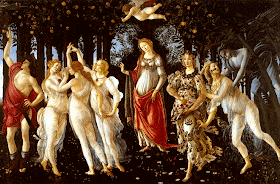As Mary and Kenna talk about in the two different, coinciding movements within German Expressionism. Though each group's approach varied, their influences were quite the same.
 |
| The Scream by Edvard Munch |
 |
| Guitar Player by Picasso |
 |
| Where do we come from... by Paul Gauguin |
These are examples of artist both groups of German Expressionists were looking to for their style. Mostly, they took away from the black outlines, the odd coloring, and the expressive use of brushstrokes. From artists like Gauguin (who has a great amount of work inspired by Tahiti and its people), they also found the sense of primitivism inspiring.
 |
| Street, Dresden 1908 by Ernst Ludwig Kirchner |
Kirchner was one of the leaders of "The Bridge" movement--whose goal was to "build a bridge to a better future". The Bridge group often painted what they didn't like seeing in the world, such as children being ignored as the women of the street go about their business.
 |
| Crucifixion by Emil Nolde |
The German Expressionists often pulled from religious reminders to try and bring a sense of morality back to society as well.
 |
| Composition 8 by Wassily Kandinsky |
Kandinsky was a main painter in the Blue Rider movement, the second half of the German Expressionists. They were more likely to paint either what they saw as the solution, or the beauties they wished to preserve in the world. Kandinsky, especially, worked with the idea of "synesthesia"-- a condition where other senses come into play where they might not with others. For example, looking at a Kandinsky can immediately give a sense of music (rhythm, tone, key, etc). Many of his pieces often pulled from music, which is why many are named with musical terms.
 |
| Blue Horses by Franz Marc |
 |
| Happy Yellow Cow by Marc |
 |
| Fate of the Animals by Marc |
Marc had his own sense of color symbolism. While he more often painted in line with the Blue Rider movment,
Fate of the Animals was seen, even by himself, as a prophesy of World War I, which would end the German Expressionist movement. Marc also often used animals, as he found them much purer than man.
If you have topics in art history you're just itching to hear more about, leave us a comment or email us at: uvu.artsandfacts@gmail.com.




























































